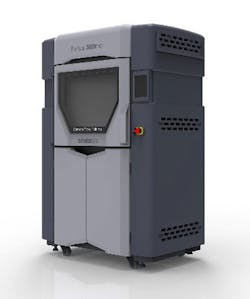With a growing demand for strong and lighter parts at an affordable cost, manufacturers look to carbon fiber. Unfortunately, the process takes time, manual labor, and might experience variations from part to part. There is a demand for automating carbon fiber processes. 3D printing has integrated carbon fiber, but like the traditional process, it took time and while it reduced cost by minimizing manual labor that was offset but expensive machines. Stratasys previewed at RAPID 2018 a new carbon fiber printer that reduces the barrier with an industrial quality system that is being offered at $70,000 USD. The 3D printer, Fortus 380 CFE, began shipping last week.
Recently, composite materials have seen a year-over-year market growth between 8 to 12%. Carbon fiber composite applications and carbon fiber reinforced polymers are considered clean energy technologies by the U.S. Department of Energy because they enable “light-weighting,” which reduces energy consumption. It’s estimated that each ten percent reduction in vehicle mass drives a six to eight percent increase in fuel economy.
For both its IndyCar and NASCAR race cars, Team Penske uses FDM to produce prototypes and end-use parts from carbon-fiber-filled Nylon 12 composite material. The team recently used the composite to produce a mirror housing for its NASCAR race teams. After designing the mirror housing, engineers then customized the design for each of their Cup Series drivers before building the final parts from the composite via FDM. The carbon-fiber based material enabled Team Penske to produce lightweight mirror housings with high impact resistance and high stiffness, each of which is critical in motorsports. The composite’s stiffness is especially beneficial when making thin-walled parts, so the parts won’t flex under the aerodynamic loads produced on track.
Additive applications for carbon-fiber filled Nylon12 may include:
- Functional prototyping of composite or metal parts
- Short production runs in a high-strength material
- Producing lightweight assembly tools for better ergonomics and reduced worker fatigue
- Replacing metal parts with high strength, lightweight composite ones
Stratasys expects the quickest adopters of its Fortus 380 CFE 3D Printer to be those making tooling and fixtures and those in industries that include Automotive; Recreational Sporting Equipment; Marine; Orthosis and Prosthesis; Defense; Aerospace; Medical Equipment; Oil and Gas.
Similar to a typical injection molded carbon fiber reinforced plastic part, Stratasys Nylon 12CF is 35 percent chopped carbon fiber by weight, and it exhibits the highest stiffness-to-weight ratio of any FDM or FFF 3D printed part.
The Fortus 380 CFE
- Layer thickness of 0.010 in. (0.254 mm)
- Layer thicknesses (ASA thermoplastic) 0.010 or .005 in. (0.127 mm)
- Build chamber 14 x 12 x 12 in. (355 x 305 x 305 mm)
- Water-soluble support material removal
- Four times stronger than a competitively priced alternative in the X and Y axis
- Maintain its mechanical properties at a 40 percent higher temperature
- Between two and five times faster than the competitively priced carbon-fiber-based 3D printer.
The Fortus 380mc Carbon Fiber Edition 3D Printer and a Team Penske NASCAR race car will be on display at the Stratasys IMTS booth # 431600 September 10 — 15 at Chicago’s McCormick Place.



